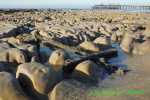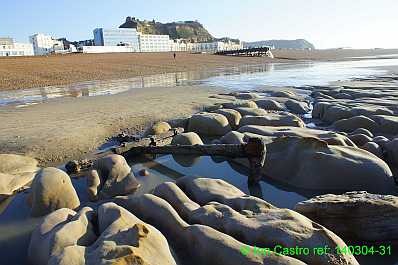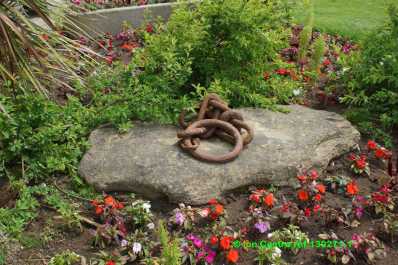
Victorian Pulling-off Anchor found

 |
Victorian Pulling-off Anchor found |
 |
|
|
|
 Another view of the anchor |
|
A huge anchor appeared on the beach opposite Harold Place. The combination of the winter storms of 2013/14 and the longest tides of the year has revealed a long-lost ‘pulling off’ or ‘hauling off anchor’ firmly wedged in the rocks in front of the former slipway by the Queens Hotel. This area of beach had been covered by a sandbank for generations and following the storms, has only just become visible – and that’s why the rocks are not covered with marine growth as might be expected. It’s fairly well known that capstans would have been located on the beach above the high-tide line at landing places to ‘haul in’ boats when they were run ashore at high tide to unload their cargo right up to the 1890’s, not just fishing boats as in the old town but coasters and colliers in other parts of the borough with established slipways such as Warrior Square, London Road (where two of the three anchors located there can still be seen at very low tides), and Grosvenor Gardens and additionally, pleasure boats were beached at the Queens Hotel. But how were the boats ‘hauled off’? A single fluke anchor, like a huge hook would have been permanently located as far down the beach as possible, and when the time came to refloat or launch the boat a line would be attached to this anchor allowing the boat to be ‘hauled off’, probably using the vessel’s own onboard capstan. Queens Hotel was the last slipway to be regularly used right up until the demise of the ‘New Albertine’ in 1924 but the anchor remains as a reminder, and another, even more deeply buried so that only the tip of the fluke can be seen (was this a complete anchor or was it a single fluke one that had turned through 180 degrees?), the fluke can be seen on bottom left of the picture and the eye at the top of the anchor on the right, the rest of the anchor being deeply buried. These were not the only surprises to be revealed, graffiti carved as long ago as 1885 was also uncovered, ‘LB 1885’ in a square can clearly be seen and not far away, on another rock, ‘Eric Walters’ – were these people waiting for their turn for a trip on the ‘Albertine’, or maybe just day-trippers from London idling on the closest bit of beach to Hastings Station. The aerial picture, from the early 1920’s shows the ‘New Albertine’ pulled up on the beach with the single capstan above it – Sidney Little’s new promenade and underground parking was yet to cut off the slipway from the sea. An earlier picture, advertising trips on the ‘Albertine’ for 1/- (5p) features two capstans – notice the treads on the ‘capstan ring’ to assist grip when heavy boats were being ‘hauled up’. These capstans would have been firmly chained to a ‘frapping stone’, a large boulder with a chain attached buried a little further inland to stop the capstan being pulled out to sea when in use – examples of these stones can be seen outside the Fishermen’s museum and there’s another one, (pictured) on show in the flowerbed outside the main Museum in John’s Place. Louis Levy’s magnificent picture shows the fully laden ‘New Albertine’ about to be launched but no sign of the hauling-off anchor. The 1880’s picture from the castle shows a collier being unloaded on the beach but the anchor, if visible would have been covered by the tide. The end of Beach Terrace in front of Pelham Crescent can clearly be seen on the lower left. A shot from beach level, probably in the 1880’s shows small craft pulled high up on the beach and probably drying their sails whilst a collier is being unloaded – note the horses and carts. This article is an adaptation of the one that first appeared in 'Hastings Town' vol 75 Ion Castro 10th March 2014 |
|
|
|
|
|
|
 'Frapping Stone' now located outside Hastings Museum |
|
 1880's picture - collier being unloaded |
|
 'The Albertine' |
 'New Albertine' beached at Hastings, note single capstan |
 A collier (coal boat) beached and unloading by the Queens Hotel in Hastings and right, 'The New Albertine' - replacement for 'The Albertine' |
|
 |
 Two capstans and aplaccard advertising trips on 'The Albertine' and left, an earlier view from the castle, probably 1860's - note absence of Hastings Pier. |
![]()
www.1066.net - Hastings' favourite web site is sponsored by XL(2000)Ltd
Photos copyright (c) Ion Castro 2014
140311 140316 150417